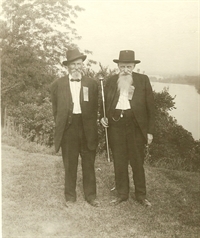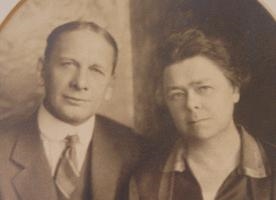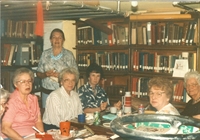In 1899 the Illinois Historical Society was created as a need was seen to collect, preserve and disseminate information relating to Illinois in general. On August 9th, 1905, the Rock Island County Historical Society was legally organized corporation under the laws of the state of Illinois. Six men signed the constitution becoming members, William A. Meese, W.F. Eastman, O.
Frederick Anderson, George E. Holt, Joseph B. Oakleaf, and William Runge. The Society's first President was William A. Meese, an attorney and Moline resident, and their first secretary was G. E. Holt. The historical society was created in 1905 as citizens of the county saw the need to preserve our history locally. The Society mission at the time was creation was “to study and learn, to collect and preserve, and to disseminate the history of Rock Island County.” Over the last 100 years the Society’s mission has remained the same. For the first seven of the Society’s existence, their members would meet in various locations in Rock Island County to present papers on Rock Island County history, including the Rock Island Club (right).
The Society had little growth from 1905 - 1912 for multiple reasons. First, many Rock Island County citizens viewed Society as social club for men. Second, the majority of papers and presentations were only focused on Moline and Rock Island history, and many men from the Upper and Lower County areas could not relate to the topics that were being presented. Third, only men could join the Society. Meese and Hauberg realized that the Society needed to broaden themselves to a wider audience if they were going to increase membership. Meese and Hauberg decided that they needed to include history from around the county, as well as including women in the membership.
In 1912, the Society reorganized. Twenty-one new people signed the constitution becoming members, Phil Mitchell, William Payne, R.W. Olmsted, Nettie Bartholomew Anderson, William H. Lyford, M.D., O.S. Holt, M.D. Hauberg, J.B. Eckhart, Mrs. Rebecca M. Simon, F.O. Van Galder, Ira O. N.orthstein, Leopold Simon, Anna T. Bromley, Thomas Bollman, Oloff Atkinson, M.S. Yeagy, E.B. McKown, Q.C. Wenger, K.T. Anderson, John H. Hauberg, and C.P. O'Haver. William A. Meese remained president, Phil Mitchell became Vice-President, Mrs. K.T. Anderson became Treasurer, and John H. Hauberg became Secretary. At this time John H. Hauberg, and sometimes his wife Susanna started traveling around Rock Island County personally interviewing pioneers (pioneers a

nd signers Marx D. Hauberg and Thomas Bollman on right), and the descendants to pioneers to preserve and study the lives of the pioneers that built our county. Hauberg instituted a Spring and Fall Dinner open to the public, on Rock Island County historical topics, which are still held to this day.
As early as 1915, members of the Society started to discuss finding a permanent home for the Society's and its papers and artifacts. The Society started to plan Fort Armstrong Centennial Celebration, which was held on June 18th-24th, 1916. In 1916, John Hauberg was named curator of the Society, and he would remain curator until he was elected President in 1917. O.S. Holt, was elected secretary, however Holt would only be secretary for approximately one year, as he would pass away on January 8, 1918. Holt was a Rock Island County/ Moline Pioneer, and business man, and a local historian. In 1919, the Society started to display their artifacts at the Rock Island County Court House, as they continued to contempt a permanent home for their collection. The Society would consider a number of options throughout the years, including the old county jail, and the basement of the Court House.
From 1920 to 1926, Matthew J. McEniry would be President, Phil Mitchell-Vice-President, Mrs. K.T. Anderson-Secretary, Arthur Burrall-Treasurer, and John H. Hauberg-Curator. During these years, the Society would focus on collecting the history of the service men from Rock Island County that participated in WWI, and our county's response to WWI. Phil Mitchell would become President in 1926, but he would pass away on November 26, 1926. John H. Hauberg would take over the responsibility of President after Mitchell's death until February 7, 1939, when Hauberg would be elected to the position. Over the next twelve years, the Society did not function visible organization, but internally, John H. Hauberg, and members of the Society were still preserving the history of Rock Island County. Hauberg would serve as the elected President until 1942, and then as Honorary President until 1946, with Henry F. Staack as President. The Society would sponsor the Indian Corn Project at Black Hawk State Park in 1944, conducted by Claire Golden, a future President of the Society.
In 1946, Oscar L. Nordstrom was elected President of the Society, with John H. Hauberg as Honorary President. In 1947, the Society's constitution was changed to have fifteen Board Members, rather than nine. On May 28, 1952, the Society hosted a "John Hauberg Night," at the Spring Dinner to honor the man who had done so much for our community, and to preserve

the history of our county. Claire Golden would be elected President on May 10, 1952 to March 1955, and John Hauberg would continue as Honorary President until his death on September 13, 1955. Joseph R. Rosborough would serve as President from 1955 until 1957. During Roseborough's Presidency, Claire Golden would move that an Endowment Fund be created, and it was seconded and carried. By 1957, there was $5,558.10 in the account, and the Society decided to store their collections in the Hauberg Civic Center, while they would continue to look for a permanent home.
In 1961, Col. Carl A. Waldmann became President of the Society.The dream of a permanent home for the Society would become a reality in 1962. After the death of Burton F. Peek, Mrs. Charles Deere Wiman would purchase the house to give to the Society to use as a library and a museum. From 1962 to 1966, the Society worked to prepare the house for researchers and visitors. During the renovation, Herbert W. Coddington would become President of the Society in May of 1964, until his death in 1968. On May 15, 1966, the house opened to the public with over 400 visitors, marking a new beginning for the Society. Clarence Skinner, Vice President moved to the President position, and would continue to be president until 1976. In the fall of 1976, the Society was offered ornamental iron fence from Arsenal Island. In 1976, the Society also saw their first female President, Virginia L. Dahlberg, followed by Franklin L. Nelson from 1979-1981. Howard M. Parkhurst would become President in 1981, but

he would pass away on September 3rd, 1981.
Dave Coopman became President after Parkhurst until May 15, 1983. In 1981, N. Lucille Sampson would become the archivist a the Society. Lucille kindness and love of history would continue to propel the Society to this day. President Coopman would place a great deal of importance on the necessity of building a library building for the Society's growing collection. James Sampson would become President after Coopman until 1988, as Dave Coopman became the fundraising chairman for the Library Fund Drive. President Sampson would continue the push for library, by creating a budget for the building and reducing costs to support an additional building, making the goal seem attainable for the Society. After a successful membership drive, the Society would have 726 members, which raised helped to raise money for a the new library. Ground was broken, and the new library was completed in 1992, and was opened on December 18, 1992. In 1992, the library seemed bare, but now in 2013, we are bursting at the seams because of the size of our collections, which have no grown to over 400 archival collections, over 10,000 photographs, 6,000 books, 40,000 vertical files, 9 newspapers in print, and over 600 reels of microfilm.